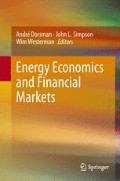Abstract
Natural gas consumption in the future is expected to increase due to its low environmental impact, ease of use and rise in the number of natural gas-fired power plants. This chapter measures natural gas supply security in six Asian economies including Japan, Korea, China, India, Singapore and Thailand from 1996 to 2009. Disruptions to long term security of supply can be caused by inadequate investments in production and transmission infrastructure, lack of supply diversity and import dependency. A composite gas supply security index is derived from four indicators of security of gas supply, with a higher index indicating higher gas supply vulnerability. Results show that China and India are the least vulnerable in terms of natural gas security because of their significant domestic gas production and small share of gas in the energy mix. Thailand is the most vulnerable among the countries studied due to its high reliance on natural gas to power its electricity generation industry as well as its greater exposure to geopolitical risks. With these analyses, governments can target possible sources of supply disruptions and mitigate their effects. Diversification is highly encouraged to spread the risk across different import and energy sources.
Access this chapter
Tax calculation will be finalised at checkout
Purchases are for personal use only
References
APERC (Asia Pacific Energy Research Centre). (2007). A quest for energy security in the 21st century: Resources and constraints. Tokyo, Japan: Institute of Energy Economics.
APERC (Asia Pacific Energy Research Centre). (2008). APEC energy overview 2007. Tokyo, Japan: The Institute of Energy Economics.
British Petroleum (BP). (2010). BP statistical review of world energy June 2010. Retrieved from http://www.bp.com/liveassets/bp_internet/globalbp/globalbp_uk_english/reports_and_publications/statistical_energy_review_2008/STAGING/local_assets/2010_downloads/statistical_review_of_world_energy_full_report_2010.pdf)
British Petroleum (BP). (2011). BP statistical review of world energy June 2011. Retrieved from http://www.bp.com/statisticalreview
Cabalu, H. (2010). Indicators of security of natural gas supply in Asia. Energy Policy, 38, 218–225.
Cabalu, H., & Manhutu, C. (2009). Vulnerability of natural gas supply in the Asian gas market. Econ Anal Policy, 39(2), 255–270.
Chandler, A., & Padungkittimal, N. (2008). Thai power sector. Retrieved from http://www.ctlo.com/TPS-2.htm
Costantini, V., Gracceva, F., Markandya, A., & Vicini, G. (2007). Security of energy supply: Comparing scenarios from a European perspective. Energy Policy, 35, 210–226.
de Jong, J., Maters, H., Scheepers, M., & Seebregts, A. (2007). EU standards for energy security of supply: Updates on the crisis capability index and the supply/demand index quantification for EU-27. The Netherlands: Energy Research Centre of the Netherlands and Clingendael International Energy Programme.
Dolader, J. (2003, June). Gas security of supply in a liberalised market. Paris: IEA.
Economist Intelligence Unit. (2010, November). Thailand: Energy report. Retrieved from http://www.eiu.com/index.asp?layout=ib3Home&pubtypeid=1142462499
Energy Market Authority (EMA). (2010). LNG terminal development. Singapore: EMA. Retrieved from http://www.ema.gov.sg/page/21/id:50/
Energy Information Administration (EIA) (2007). Energy Profile of Singapore, in Encyclopaedia of Earth. Retrieved from http://www.eoearth.org/article/Energy_Profile_of_Singapore
Energy Information Administration (EIA). (2011). Annual energy outlook 2011: With projections to 2035. Washington, DC: EIA. Retrieved from http://www.eia.gov/forecasts/aeo/pdf/0383(2011).pdf/
Energy Information Administration (EIA). (2012). Energy Profile of India, in Encyclopaedia of Earth. Retrieved from http://www.eoearth.org/article/Energy_profile_of_India
Gnansounou, E. (2008). Assessing the energy vulnerability: Case of industrialised countries. Energy Policy, 36, 3734–3744.
Gupta, E. (2008). Oil vulnerability index of oil-importing countries. Energy Policy, 36, 1195–1211.
Higashi, N. (2009, June). Natural gas in China: Market evolution and strategy. (Working Paper Series). Paris, France: International Energy Agency.
International Association for Energy Economics (IAEE). (2007). Natural gas: Is there a decreasing trend? IAEE Newsletter, 16 (Third Quarter).
International Energy Agency (IEA). (2007). Natural gas market review 2007: Security in a globalising market to 2015. Paris, France: International Energy Agency.
International Monetary Fund (IMF). (2010). World economic outlook database. Washington, DC: IMF. Retrieved from http://www.imf.org/external/pubs/ft/weo/2009/01/weodata/index.aspx
Jackson, M. (2007, October). The future of natural gas in India: A study of major consuming sectors (Working Paper #65). Stanford, CA: Program on Energy and Sustainable Development, Stanford University.
Jansen, J. C., van Arkel, W. G., & Boots, M. G. (2004). Designing indicators of long-term energy supply security. Petten, The Netherlands: ECN.
Kendell, J. (1998). Measures of oil import dependence. Washington, DC: Energy Information Administration, U.S. Department of Energy. Retrieved from http://www.eia.doe.gov/oiaf/archive/issues98/oimport.html
Komiyama, R., Zhidong, L., & Ito, K. (2005). World energy outlook in 2020 focusing on China’s energy impacts on the world and Northeast Asia. International Journal of Global Energy Issues, 24(3–4), 183–210.
Percebois, J. (2006). Dépendance et vulnérabilité: deux façons connexes mais différentes d’aborder les risques énergétiques. (Cahiers de recherché CREDEN, No. 06.03.64). Montpellier, France: CREDEN.
Percebois, J. (2007). Energy vulnerability and its management. International Journal of Energy Sector Management, 1, 51–62.
Reymond, M. (2007). European key issues concerning natural gas: Dependence and vulnerability. Energy Policy, 35, 4169–4176.
Thacker, S. (2006). Recent Indian petroleum, petroleum products and natural gas regulations. Hydrocarbon World, 23–24.
United Nations Development Programme (UNDP). (2007). Overcoming vulnerability to rising oil prices: Options for Asia and the Pacific. Bangkok: UNDP Regional Centre.
World Bank. (2009). Worldwide governance indicators1996–2008. Washington, DC: World Bank. Retrieved from http://info.worldbank.org/governance/wgi/index.asp
World Energy Council. (2008). Europe’s vulnerability to energy crises. London, United Kingdom.
Author information
Authors and Affiliations
Corresponding author
Editor information
Editors and Affiliations
Appendix
Appendix
Rights and permissions
Copyright information
© 2013 Springer-Verlag Berlin Heidelberg
About this chapter
Cite this chapter
Cabalu, H., Alfonso, C. (2013). Energy Security in Asia: The Case of Natural Gas. In: Dorsman, A., Simpson, J., Westerman, W. (eds) Energy Economics and Financial Markets. Springer, Berlin, Heidelberg. https://doi.org/10.1007/978-3-642-30601-3_2
Download citation
DOI: https://doi.org/10.1007/978-3-642-30601-3_2
Published:
Publisher Name: Springer, Berlin, Heidelberg
Print ISBN: 978-3-642-30600-6
Online ISBN: 978-3-642-30601-3
eBook Packages: Business and EconomicsEconomics and Finance (R0)

